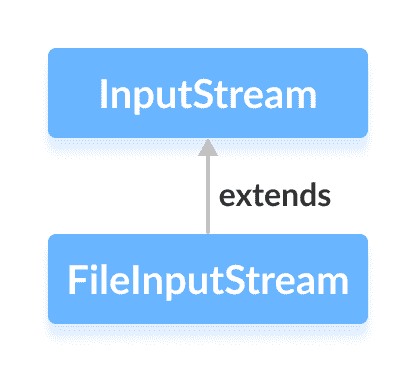原文: https://www.programiz.com/java-programming/fileinputstream
在本教程中,我们将借助示例学习 Java FileInputStream及其方法。
java.io包的FileInputStream类可用于从文件中读取数据(以字节为单位)。
它扩展了InputStream抽象类。

在学习FileInputStream之前,请确保了解 Java 文件。
创建一个FileInputStream
为了创建文件输入流,我们必须首先导入java.io.FileInputStream包。 导入包后,就可以使用 Java 创建文件输入流。
1.使用文件路径
FileInputStream input = new FileInputStream(stringPath);
在这里,我们创建了一个输入流,该输入流将链接到path指定的文件。
2.使用文件对象
FileInputStream input = new FileInputStream(File fileObject);
在这里,我们创建了一个输入流,该输入流将链接到fileObject指定的文件。
FileInputStream的方法
FileInputStream类提供了InputStream类中存在的不同方法的实现。
read()方法
read()- 从文件中读取一个字节read(byte[] array)- 从文件中读取字节并将其存储在指定的数组中read(byte[] array, int start, int length)- 从文件中读取等于length的字节数,并从位置start开始存储在指定的数组中
假设我们有一个名为input.txt的文件,其内容如下。
This is a line of text inside the file.
让我们尝试使用FileInputStream读取此文件。
import java.io.FileInputStream;public class Main {public static void main(String args[]) {try {FileInputStream input = new FileInputStream("input.txt");System.out.println("Data in the file: ");// Reads the first byteint i = input.read();while(i != -1) {System.out.print((char)i);// Reads next byte from the filei = input.read();}input.close();}catch(Exception e) {e.getStackTrace();}}}
输出
Data in the file:This is a line of text inside the file.
在上面的示例中,我们创建了一个名为input的文件输入流。 输入流与input.txt文件链接。
FileInputStream input = new FileInputStream("input.txt");
为了从文件中读取数据,我们在while循环中使用了read()方法。
available()方法
要获得可用字节数,我们可以使用available()方法。 例如,
import java.io.FileInputStream;public class Main {public static void main(String args[]) {try {// Suppose, the input.txt file contains the following text// This is a line of text inside the file.FileInputStream input = new FileInputStream("input.txt");// Returns the number of available bytesSystem.out.println("Available bytes at the beginning: " + input.available());// Reads 3 bytes from the fileinput.read();input.read();input.read();// Returns the number of available bytesSystem.out.println("Available bytes at the end: " + input.available());input.close();}catch (Exception e) {e.getStackTrace();}}}
输出:
Available bytes at the beginning: 39Available bytes at the end: 36
在上面的示例中,
- 我们首先使用
available()方法检查文件输入流中的可用字节数。 - 然后,我们已使用
read()方法 3 次从文件输入流中读取 3 个字节。 - 现在,在读取字节之后,我们再次检查了可用字节。 这次,可用字节减少了 3。
skip()方法
要丢弃并跳过指定的字节数,可以使用skip()方法。 例如,
import java.io.FileInputStream;public class Main {public static void main(String args[]) {try {// Suppose, the input.txt file contains the following text// This is a line of text inside the file.FileInputStream input = new FileInputStream("input.txt");// Skips the 5 bytesinput.skip(5);System.out.println("Input stream after skipping 5 bytes:");// Reads the first byteint i = input.read();while (i != -1) {System.out.print((char) i);// Reads next byte from the filei = input.read();}// close() methodinput.close();}catch (Exception e) {e.getStackTrace();}}}
输出:
Input Stream after skipping 5 bytes:is a line of text inside the file.
在上面的示例中,我们使用skip()方法从文件输入流中跳过 5 个字节的数据。 因此,不会从输入流中读取代表文本This的字节。
close()方法
要关闭文件输入流,可以使用close()方法。 调用close()方法后,我们将无法使用输入流读取数据。
在以上所有示例中,我们都使用close()方法关闭文件输入流。
FileInputStream的其他方法
| 方法 | 内容描述 |
|---|---|
finalize() |
确保调用close()方法 |
getChannel() |
返回与输入流关联的FileChannel的对象 |
getFD() |
返回与输入流关联的文件描述符 |
mark() |
标记输入流中已读取数据的位置 |
reset() |
将控件返回到输入流中设置了标记的点 |
要了解更多信息,请访问 Java FileInputStream(官方 Java 文档)。

